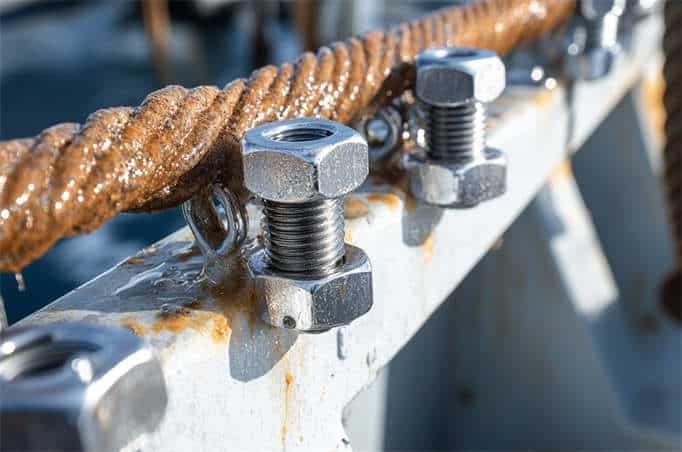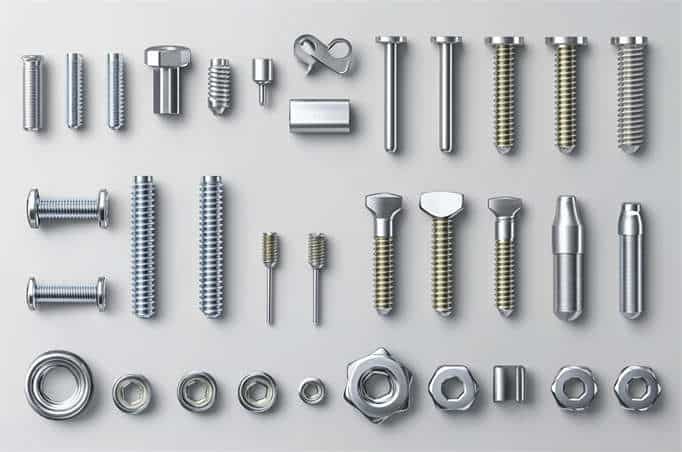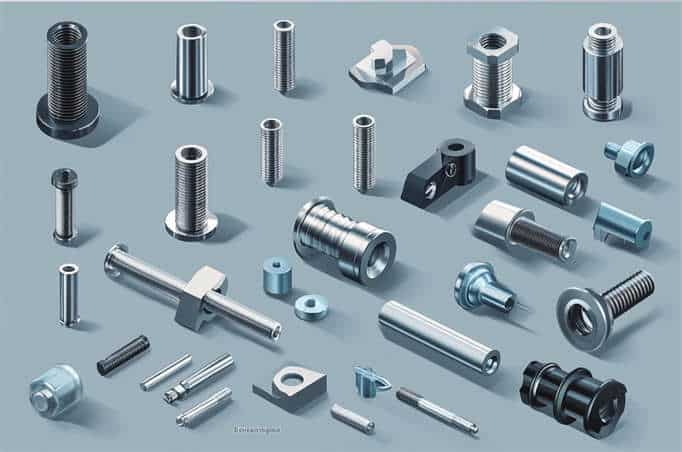In engineering and construction, every detail matters, especially those seemingly small components that bear significant responsibility. Prince Fastener, a fastener manufacturer with years of experience, understands this well. We take pride in producing 316 stainless steel fasteners, a material internationally recognized for its excellent corrosion resistance and fracture toughness. Today, through this blog, we want to share the features of 316 stainless steel fasteners, including their unique material properties, diverse applications, and the various surface treatment methods we offer. This content will help you better understand why Prince Fastener’s 316 stainless steel fasteners are indispensable to your construction projects.

316 SS Fasteners
316 ss fasteners are a vital industrial material widely used in various engineering fields due to their outstanding corrosion resistance and fracture toughness. Below are some critical details about 316 stainless steel fasteners:
Material Properties
- Corrosion Resistance:
- 316 stainless steel is a typical molybdenum-containing austenitic stainless steel. It provides stronger corrosion resistance than 304 stainless steel, especially in chloride conditions, where it exhibits superior pitting and crevice corrosion resistance.
- Heat Resistance:
- The molybdenum content in 316 stainless steel enhances its high-temperature properties, though its performance declines above 500°C.
- Composition:
- 316 stainless steel comprises carbon (C), silicon (Si), manganese (Mn), phosphorus (P), sulfur (S), chromium (Cr), nickel (Ni), and molybdenum (Mo). Specific composition details are provided in the ASTM A276/A276M-2017 standards.
Main Applications
- Marine Resources:
- 316 stainless steel, often called “marine-grade” stainless steel, is suitable for marine applications due to its ability to resist seawater and salt solution corrosion.
- Chemical Industry:
- They are widely used in chemical processing fields, especially in environments involving seawater or saltwater solutions.
- Food Industry:
- Applicable to seafood processing and high-chloride exposure environments.
- Aerospace Engineering:
- They are used to manufacture high-strength, corrosion-resistant aircraft components and fasteners.
- Medical Devices:
- It is ideal for making corrosion-resistant surgical tools and cardiovascular devices requiring sterilization.
What Are the Common Surface Treatments for 316 SS Fasteners?
Joint surface treatment methods for 316 ss fasteners include:
- Zinc Plating:
- A cost-effective and aesthetically pleasing method that can produce black or military-green finishes. However, zinc plating offers relatively low corrosion resistance.
- Passivation:
- It improves the corrosion resistance of stainless steel fasteners, enhances surface gloss, increases flexibility, and reduces the risk of cracking during use.
- Pickling:
- Removes the oxide layer formed after high-temperature treatment and any rust or surface contaminants from stainless steel fasteners.
- Electroplating:
- It covers the stainless steel surface with a metal or alloy layer to improve appearance, corrosion resistance, and conductivity. Common electroplating layers include chrome and nickel.
- Polishing:
- Using mechanical or chemical methods, polishing creates a mirror-like smooth surface, enhancing aesthetics and reducing microscopic surface irregularities.
- Sandblasting:
- Utilizes high-speed sand particles to impact the stainless steel surface, achieving a specific roughness, improving adhesion, and providing decorative effects.
- Chemical Polishing:
- Achieves a smooth surface through chemical methods, improving aesthetics.
- Dacromet Coating:
- This treatment avoids hydrogen embrittlement issues, offers excellent torque-tension consistency, and has significant environmental pollution concerns.
- Phosphating:
- Forms a protective film on the metal surface through chemical conversion coating, enhancing corrosion resistance and wear resistance.
- Anti-rust Oil Coating:
- Applying anti-rust oil on the stainless steel surface provides additional corrosion resistance.
Select the appropriate surface treatment method based on different requirements and applications to enhance corrosion resistance, aesthetics, or other characteristics.
Which Is the Most Durable Surface Treatment for 316 SS Fasteners?
The most durable surface treatments for 316 ss fasteners typically include the following:
- Passivation:
- Passivation enhances the corrosion resistance of 316 stainless steel fasteners, improves surface gloss, increases flexibility, and reduces the risk of cracking during use.
- Electroplating:
- Electroplating adds a protective layer of metal or alloy (e.g., chrome or nickel) to the stainless steel surface, improving durability. Zinc or nickel plating can provide additional protection and enhance corrosion resistance.
- Hot-dip Galvanizing:
- Although it may cause issues like zinc buildup and burrs on screws or embedded holes, hot-dip galvanizing remains effective in improving corrosion resistance. Vacuum powder zinc diffusion is an advanced hot-dip galvanizing technique that overcomes these issues, ensuring uniform zinc coating thickness even in threads, corners, or recesses.
- Zinc Diffusion:
- The zinc-iron alloy layer formed is dense, firmly bonded to the substrate, and highly resistant to abrasion. Its hardness is double that of the steel, offering superior durability compared to traditional hot-dip galvanizing.
- Dacromet Coating:
- This method avoids hydrogen embrittlement issues, provides excellent torque-tension consistency, and is highly durable, though it has significant environmental drawbacks.
Considering corrosion resistance, wear resistance, and aesthetics, passivation and electroplating (especially zinc and nickel plating) are among the most durable surface treatments for 316 stainless steel fasteners.
Which Surface Treatment Lasts Longest in Humid Environments?
Passivation is the longest-lasting surface treatment for 316 ss fasteners in humid environments.
- Passivation significantly enhances the corrosion resistance of 316 stainless steel, ensuring long-term durability in humid and corrosive environments.
- It effectively reduces replacement frequency and ensures stability during prolonged use, making it ideal for marine, coastal, and damp conditions.
Is Passivation Suitable for All Types of Stainless Steel?
Yes, passivation is generally suitable for stainless steel. Research shows passivation applies to all SUS200, SUS300, and SUS400 series stainless steels.
- Passivation creates a dense oxide film (primarily chromium oxide) on the stainless steel surface, significantly improving its corrosion resistance.
- It prevents localized corrosion and prolongs the lifespan of stainless steel in corrosive environments.
Thus, passivation is a widely used surface treatment process for different types of stainless steel.
What Are the Differences Between Zinc Plating and Passivation for 316 SS Fasteners?
Zinc plating and passivation are two distinct surface treatment processes with differences in purpose, performance, and application:
Zinc Plating:
- A process of covering the metal surface with a layer of zinc to prevent corrosion.
- The zinc layer isolates air and moisture, protecting the base material.
- Cost-effective, easy to use, and suitable for mass production.
- Provides a smooth surface requiring minimal maintenance.
- The zinc layer may corrode faster in extreme environments (e.g., marine or acidic).
Passivation:
- It involves treating stainless steel with a chemical agent to create a stable, protective oxide film.
- Enhances corrosion resistance, especially in harsh environments.
- Improves adhesion for subsequent coatings and overall protection.
- Environmentally friendly options (chromium-free passivation agents) are available.
Key Differences:
- Functionality: Zinc plating forms a primary protective layer; passivation enhances corrosion resistance by creating a passive film.
- Application: Zinc plating is suitable for general metal protection, while passivation is ideal for highly corrosive environments.
- Cost: Zinc plating is cheaper, while passivation involves more complex processes and is relatively more expensive.
Zinc plating suffices for general corrosion protection. However, passivation is the better choice in high-corrosion environments or where durability is critical.
What Is the Cost Difference Between Zinc Plating and Passivation?
The cost difference between zinc plating and passivation primarily involves:
- Zinc Plating Costs:
- Zinc plating is relatively affordable. Costs are typically calculated per kilogram. For example:
- Barrel zinc plating costs approximately 10 RMB/kg.
- Torque-preload consistency for zinc-plated fasteners is weak, making it unsuitable for critical connections.
- Passivation Costs:
- Passivation involves more complex procedures, so its costs are higher.
- The cost difference between passivated and non-passivated components is approximately 15–20%.
Environmental protection cost: Traditional chromate passivation agents have dominated the market due to their excellent treatment effects. However, with the strengthening of environmental regulations and the continuous development of alternatives, their costs are also slowly rising. Non-chromium passivation agents are low in cost and are a more economical choice. New environmentally friendly passivation agents are more expensive but have better performance and higher growth value and are competitive in high-end application ranges.
Galvanizing costs are relatively low, and passivation treatment has relatively high costs due to its additional protection effects and environmental regulations. The specific choice of which process must be determined based on actual business needs and natural standards. Electro galvanizing is sufficient to meet general anti-corrosion coatings regulations. However, if it is in a highly corrosive environment or an area with high requirements for product durability, passivation is undoubtedly the best choice, although it is costly.



















